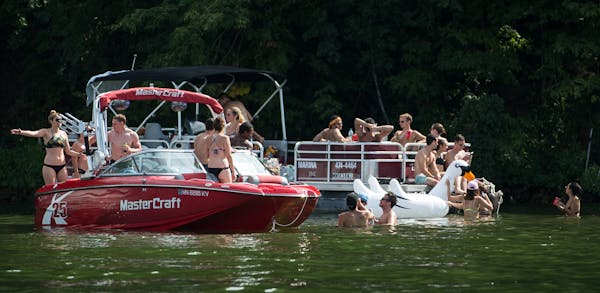Authorities recovered the body of a 35-year-old man last week who went missing while paddleboarding on Lake Waconia, marking the 17th boating-related death in Minnesota in 2016.
According to new preliminary numbers from the Minnesota Department of Natural Resources, that was one fewer boating death than in 2015, which set an 11-year-high mark with 18. But despite new efforts and ramped-up enforcement on the state's lakes and rivers, 2016 still is ending with a higher number than the average over the past decade.
"It's good the numbers went down, but if we're coming off an 11-year high, we'd hope it would be down," said Lt. Adam Block, who oversees DNR conservation officers on the west metro's lakes and rivers. "Anything more than zero is too many."
Minnesota, which ranks No. 1 nationwide for boat ownership per capita, saw an uptick in boating-related deaths in 2015 after an early ice-out and warm weather. This year's warm days, extended boating season and low gas prices boosted boating traffic on lakes and rivers again.
Boating while intoxicated (BWI) citations increased this year, with 106 compared to 81 last year and 76 in 2014. The number of nonfatal boating accidents went up this year to the highest number in eight years, with 76 boating accidents compared to 71 last year. And the state had 36 non-boating drownings, up from 35 in 2015.
Nowhere is Minnesota's popular boating scene bigger than on Lake Minnetonka, where law enforcement intensified efforts this year in new ways. At least 40 officers patrolled the lake on the July 4th holiday. Ambulances were stationed at a new boat launch, and police were deployed to the party hot spot of Big Island for the first time. Authorities in unmarked boats also targeted underage drinking, issuing 101 citations throughout the season.
But even with the new enforcement efforts, the number of fatalities on the massive lake stayed the same as last year, with two of three drownings on the lake involving boaters.
"Is there one magic answer to all of it? It's about [boaters] being responsible," Hennepin County Sheriff Rich Stanek said about ways to decrease the number of boating deaths.
All three of the fatalities on the state's most popular lake involved adults who weren't wearing life jackets and were intoxicated, Stanek said. "You see a significant trend there," he said.
The three fatalities were among seven drownings of children and adults this year across Hennepin County lakes, rivers and pools. None of them were wearing life jackets.
Alcohol is No. 1 factor
In 2017, Hennepin County authorities will continue extending safety messages and enforcement on lakes and rivers, encouraging boaters to designate a sober driver and wear a life jacket.
While the state's boating deaths number is less than other grim statistics — for instance, more than 300 people have died in traffic incidents — officials say there could be fewer still among the state's estimated 2.3 million boaters.
"We did end up higher than average," said Stan Linnell, the DNR's boating and water safety manager. "We don't want it to be headed in that direction."
Across the state, the deadliest month for boating was June. And most of this year's 17 boating-related deaths involved men, ages 20 to 60 years old, who weren't wearing a life jacket, according to the DNR.
Locally and nationally, alcohol is the No. 1 factor in boating fatalities and accidents.
"It's not worth losing your life over having a few drinks," Linnell said.
Still relatively safe
Despite the number of incidents, authorities say boating in the Land of 10,000 Lakes is still relatively safe.
According to Coast Guard data, Minnesota has a lower-than-average fatality rate compared to other states. And the number of boating fatalities in recent years pales by comparison with those in the 1960s and '70s, when the DNR first started keeping count of the incidents, with Minnesota recording nearly 60 deaths a year then. Over the following decades, the number of deaths fell as education and enforcement ramped up.
"We are making great strides forward with educating folks," Linnell said.
In 2005, the state had 23 boating-related deaths. Those numbers declined to 12, in 2008 and 2010, before rising to 18 last year.
On Minnetonka, the 14,000-acre lake can draw thousands of boaters on a summer day. With boats getting faster and bigger, and authorities seeing more distracted boaters, Block said it's likely that more accidents will happen.
"I'm honestly surprised we don't see more," he said.
Kelly Smith • 612-673-4141
Twitter: @kellystrib

Fall or spring, it's Rochester Mayo's year in prep tennis

Minneapolis reaches $150k settlement with eyewitness of George Floyd's murder

Israel-Hamas war creates 'really fraught times' at Minn. colleges

Rare and fatal brain disease in two deer hunters heightens concerns about CWD

